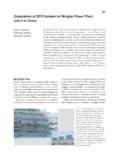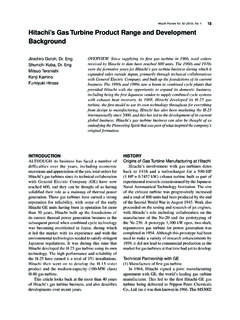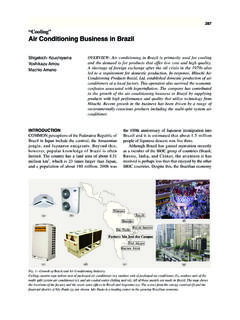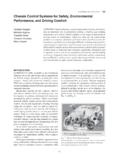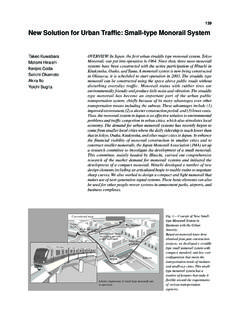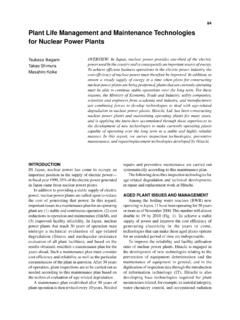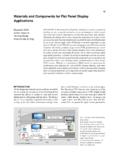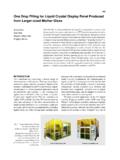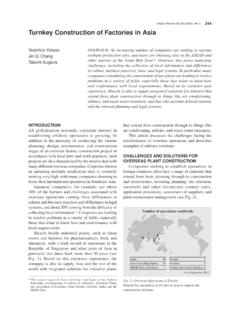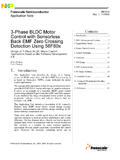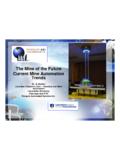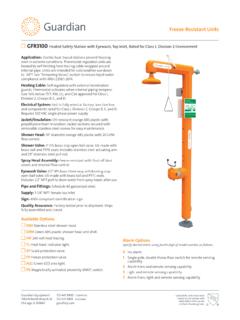Transcription of Utilization of AI in the Manufacturing Sector : Case ...
1 Hitachi Review Vol. 65 (2016), No. 6 145. Featured Articles Utilization of AI in the Manufacturing Sector case studies and Outlook for Linked Factories Naohiko Irie, Dr. Eng. OVERVIEW: Utilization of the IoT is steadily advancing in the Manufacturing Hiroto Nagayoshi Sector . In response to this trend, Hitachi is working to provide new industry Hikaru Koyama solutions based on the symbiotic autonomous decentralization concept for achieving overall optimization of activities and for creating new business by linking various systems and stakeholders together. To make new industry solutions a reality, it will be necessary to have on-site sensing, to provide an infrastructure for collecting and archiving big data, to analyze and plan countermeasures, and to give feedback to sites.
2 This article describes advanced on-site sensing, integrated analysis of a variety of on-site data for analyzing and planning countermeasures, and the Utilization of AI. technology for them. and feed back of the results obtained to the site INTRODUCTION. (Acting), thus enabling the optimization of value IN recent years, Utilization of the Internet of Things chains inside and outside of the factory. (IoT) has resulted in increasingly active trend towards This article describes new industry solutions that a new evolution of the Manufacturing industry. The will be achieved by such symbiotic autonomous Industrial Internet Consortium (IIC), which includes decentralization, and the machine learning technology General Electric Company (GE) as one of its founders, and artificial intelligence (AI) that form the core of and the government-led Industrie were established these systems.
3 In the USA and Germany, respectively. Both of these organizations are engaged in the formation and LINKED FACTORIES AND NEW INDUSTRY. standardization of a new ecosystem that involves the SOLUTIONS ACHIEVED BY SYMBIOTIC. Manufacturing industry and information technology AUTONOMOUS DECENTRALIZATION. (IT) industry. Hitachi has a track record for building large-scale Conventional optimization at production sites is control systems in diverse fields, such as energy, limited to analysis at the individual system level transportation, and water supply and sewerage, in and improvement of each site based on this, and the addition to production management systems and control effectiveness of such improvements is becoming systems designed for various Manufacturing industries saturated.
4 This is why symbiotic autonomous including steelmaking, automobiles, and medicine. decentralization is being applied to achieve linked Hitachi is leveraging its knowledge of systems such factories with a view toward optimizing activities as these to link diverse systems. It is advocating the across multiple systems and the creation of new value symbiotic autonomous decentralization concept(1) to chains. To make this a reality, Hitachi is collecting and provide value gained from this to the Manufacturing archiving information from other related systems in industry and the social infrastructure Sector , and to addition to the information gained from Manufacturing promote new growth.
5 Systems, and is also further analyzing the information Symbiotic autonomous decentralization allows of other factories that are being expanded globally, sensing of a site's various statuses (Sensing), analysis planning countermeasures, and giving feedback to of issues and planning of countermeasures based on sites with the aim of optimizing activities overall (see various collected and archived information (Thinking), Fig. 1). - 67 - 146 case studies and Outlook for Linked Factories Global bases Other industries Managers, business planners Managers, business planners Managers, business planners Insight Insight Acting Sensing Acting Sensing Insight Thinking Thinking Symbiotic autonomous decentralized platform Symbiotic autonomous decentralized platform Analysis Plan countermeasures Acting Sensing Analysis Plan countermeasures Warning sign OT IT Operational Warning sign OT IT Operational Cause analysis Scheduling Cause analysis Scheduling detection suggestions detection suggestions Security Security Data collection and archiving Feedback to site Data collection and archiving Feedback to site Thinking Thinking Thinking Thinking Thinking Symbiotic autonomous decentralized platform Analysis Plan countermeasures Warning sign Operational Cause analysis OT
6 IT Scheduling detection suggestions Security Data collection and archiving Feedback to site Thinking Thinking Thinking Sensing Acting Sensing Acting Sensing Acting Site machinery and equipment On-site systems Information systems Energy systems Logistics systems Security systems Manufacturing site systems Quality control systems OT: operational technology IT: information technology Fig. 1 Symbiotic Autonomous Decentralization Concept. Activities can be optimized in terms of management considerations and new value chains created by collecting and archiving data from a variety of on-site systems, analyzing it and planning countermeasures, and providing information back to the site as feedback.
7 Depending on the information to be combined, the (2) Supply Chain Management (SCM) coordination following types of solutions are possible. To achieve optimum operation of factories that (1) Improved energy productivity are expanding globally, site information from MESs It is predicted that energy costs will fluctuate and inventory control systems is analyzed, and high- considerably as a result of the liberalization of electric precision management indicators are evaluated by power, violent fluctuation of the crude oil price, a business value simulation tool that factors in the Utilization of renewable energy, and other factors, logistical status of each region. These indicators are and improvements in productivity to correspond with then used to determine the optimum production plan this fluctuation will be required.
8 For this reason, for each site, distribution routes, stock quantities, etc., Hitachi is collecting data on the status of energy and the production plan is then executed based on these consumption in addition to detailed production site parameters. Also, since on-site information is analyzed information from sources such as Manufacturing in real time, production capacity and inventory is execution systems (MESs) and points of production adjusted to accommodate unforeseen circumstances. (POPs), is conducting analysis regarding the relation (3) Global quality management/improvement between energy and productivity, and is formulating Ensuring consistent quality at a high level between energy procurement plans and production plans that factories that are expanding globally not only results will lead to the reduction of overall energy costs and in cost reductions but also reduces the risk of product peak shaving.
9 Formulated plans are fed back to an recalls. To accommodate this, worker actions are sensed MES and the optimum production plan is executed so by video analysis as well as detailed Manufacturing that renewable energy in the factory is used effectively information from MES and POP. The information that and energy costs are reduced. is gained is archived and analyzed so that factors that - 68 - Hitachi Review Vol. 65 (2016), No. 6 147. degrade quality can be extracted and countermeasures AI, or the like for comprehending the meaning of can be planned. Hitachi will introduce new analytical captured video are anticipated. methods such as AI since the factors that affect quality For the analysis and planning of countermeasures, are complex and are predicted to be wide-ranging.
10 It is strongly desirable to utilize AI from the viewpoint Obtained countermeasures will be fed back to workers of analyzing diverse data in an inter-disciplinary using augmented reality (AR) as well as MESs and manner to obtain new knowledge. other control systems. The following describes actual case studies where (4) Business Continuity Plan (BCP) support AI was utilized. In recent years, cyber-attacks have increased the risk of factory operations being shut down. As Application of Machine Learning to the a result, the impact on business when an incident Recognition of Work Activities occurs must be minimized. Monitoring information, Hitachi is developing a sensing technology for detected illegal access to control systems, and detected recognizing the movements of factory workers and viruses, as well as detailed information collected from for detecting worker movements that deviate from a Manufacturing systems, is collected from each base.
